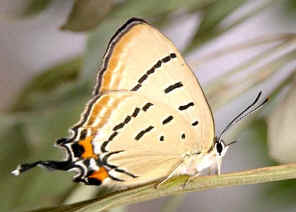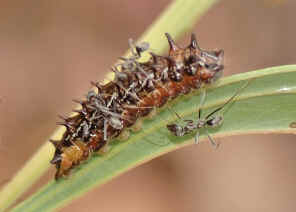Imperial Blue - Jalmenus evagoras
FAMILY LYCAENIDAE
This page contains information and pictures about Imperial Blue Butterflies in the Brisbane area, Queensland, Australia. The butterfly also known as Imperial Hairstreak.

- Wingspan 40mm
- The Imperial Blue butterflies are brownish blue on the top side and pale yellow with black lines on the underside. There are long curled tails on each hind wing. Females lay eggs on different kinds of wattles. They are locally common in Brisbane eucalypt forests, seldom seen far away from host plants.
- The top view of the open-winged butterfly look like the face of a cat, hold prey with its bloody mouth. This pattern will scare most of the birds - the butterfly's predator. About this point, we have detail discussions in this page.
- Males and females looked very similar, quite hard to distinguish on photos.


Males cluster around pupae
- Males cluster around pupae waiting for the emerge of females.
- During a sunny summer day, the male butterflies are found flying around the host plants, waiting to mate with females.



Eggs, Caterpillars and Pupa
- The eggs of this butterfly are white to pale green in colours. The eggs are laid in rows on the stems of food plant. Female will lay eggs on different type of wattle, however, she will only choose the wattle with the right type of ants colony.
- The caterpillars are quite common on Wattle Acacia leaves. They can easily be found during summer on the day time feeding on the leaves. The caterpillars and pupae are always attended by ants.
- Caterpillar 40mm The caterpillar about to turn into a pupa
- The caterpillars secrete a substance which the ants like. It is believed that the ants will provide protection from predators and parasitism as return. This is why the caterpillars can feed freely during the day time. The caterpillars usually pupate in group on a communal web spun among twigs.
Raised Imperial Blue at Home
- We striped the ants away and collected two caterpillars, raised them in a jar with some fresh Wattle leaves. Without the ants protection in the wild, scientists had shown that the caterpillar will subject to parasite or predation within days.



- A few days later, the two caterpillars turned into pupa. The two caterpillars pupated close to each others. The Pupa are dark brown in colour.
- We know that for some other blue butterfly species, the caterpillars hind during the day and rely on the ants to guide them to the food plants. This Imperial Blue caterpillar seemed living fine without those ants About a week later, the Imperial Blue butterflies came out from the pupa.
Host Plants - Wattles
- Caterpillars feed on many types of Acacia as host plants. However, females will only lay eggs on host plants that have the right species of Ants. The wattle trees selected are usually medium size young trees, about two meters high, which are in group within a small area. The wattles are those common species include Acacia leiocalyx, A. harpopylla, A. irrorata, A. melanoxylon, A. mearnsii.



Parasite
- Without the ants protection in the wild, scientists had shown that the caterpillar will subject to parasite or predation within days.
- Reference:
- 1. Insects
of Australia, CSIRO, Division of Entomology, Melbourne University
Press, 2nd Edition 1991, p 899.
- 2. Insects of Australia and New Zealand - R. J. Tillyard, Angus & Robertson, Ltd, Sydney, 1926, p465.
- 3. Create More Butterflies - by Frank Jordan and Helen Schwencke, Earthling Enterprises, 2005, p22.
- 4. Jalmenus evagoras - Australian Caterpillars, Don Herbison-Evans & Stella Crossley, 2009.
- 5. Flying Colours, Common Caterpillars, Butterflies and Moths of South-Eastern Australia - Pat & Mike Coupar,1992, p99.
[ Up ] - 2. Insects of Australia and New Zealand - R. J. Tillyard, Angus & Robertson, Ltd, Sydney, 1926, p465.

































